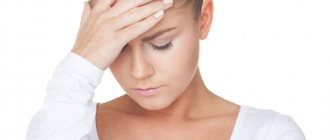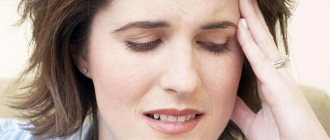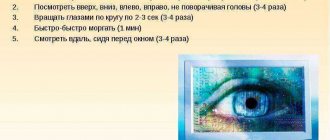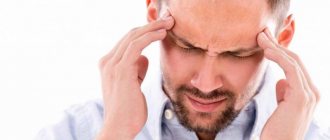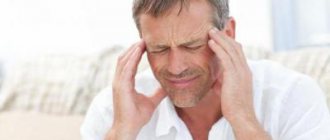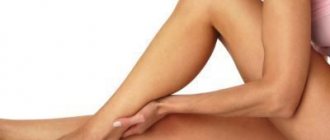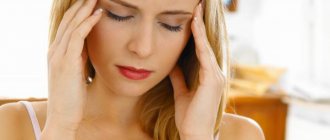Why does the scalp hurt when touched, what could it be and what treatment options are there?
A sore scalp is a common symptom.
Everyone has encountered it at least once in their life and asked themselves the question: “Why does it hurt when you touch your hair?” Pain syndrome can manifest itself for simple reasons - when wearing a headdress or having hair pulled tightly into a bun, but sometimes the problem is more serious and lies in pathologies associated directly with the scalp, blood vessels and nerve endings. In such cases, if the scalp hurts when touched, the unpleasant sensations cannot be ignored.
Household
- Hairstyles with tight balls . Hairstyles using many pins, bobby pins, hair pulled into a ponytail or bun, tightly braided braids. Changing your hairstyle often solves the problem. You can learn more about other possible causes of scalp tightening in this article.
- Naturally heavy hair . If your hair is naturally heavy, then the hair follicles may become inflamed from wearing a heavy hairstyle, and it will be painful to touch. A haircut will improve the situation.
- Hypothermia . Hypothermia – lack of headwear in cold weather. Going outside with wet hair. Hypothermia leads to inflammation of blood vessels, nerve fibers, hair follicles, and also causes vascular spasms, which again leads to pain when touched.
- Lack of hygiene . It is important to wash your hair when it gets dirty.
- Narrow hats . Hats that tightly cover the head, disrupting blood and lymphatic circulation.
- Cosmetics and preparations . Cosmetics often cause allergic dermatitis and pain as a result. Changing shampoo often solves the problem.
- Inappropriate comb . Combs with hard, sharp teeth damage the skin. Changing the comb eliminates the symptom.
Psychological
The skin on the head under the hair can also hurt when touched for psychological reasons:
- Stress.
- Psycho-emotional fatigue.
- Depression.
Physiological
- vegetative-vascular dystonia;
- inflammation of nerve processes, endings;
- allergy;
- dermatitis.
We invite you to watch a video about the reasons why your scalp may hurt:
Localization of painful sensations
Pain syndrome of the scalp spreads over its entire surface.
But there are areas where the pain is felt more strongly - under the hair on one side, for example, on the left, or in one place: behind the ear, on the top of the head, temples and in the frontal part.
The nature of the pain cannot be sudden, acute, unbearable, or occurring abruptly. The pain syndrome develops slowly, gradually, gaining strength and intensity. What can cause pain under the hair?
The localization of pain may indicate the cause:
- On the top of the head – with vegetative-vascular dystonia.
- On the back of the head – a consequence of inflammation of the nerves in the back of the head.
- Behind the ears – dental ailments, lymphadenitis, otitis media, mastoiditis.
Analyzes and examinations
If there are accompanying symptoms of itching and burning, if they are suspected of a dermatological nature, then prescribe:
- microscopic examination of scalp scraping;
- analysis of estrogen and androgen hormones to identify hormonal imbalances;
- thyroid and adrenal hormones.
The trichologist performs trichoscopy, assesses the condition of the blood vessels and the degree of damage to the scalp.
If there is a suspicion of vegetative-vascular dystonia, then get tested:
- general blood analysis;
- blood sugar test;
- blood chemistry;
- Analysis of urine;
- analysis of thyroid hormones;
- ECG;
- EchoCG;
- Ultrasound of the abdominal organs;
- Ultrasound of the thyroid gland.
If the pain is localized on one side and behind the ears - an examination by an otolaryngologist or dentist to find out exactly what it is and determine the cause of the disease.
Based on the results of the examination, the patient may be prescribed a course of treatment, the composition of which depends on the diagnosis and the extent of the lesion.
First aid at the first manifestations
Often, with chronic fatigue, emotional stress, or spring vitamin deficiency, the scalp reminds itself of itself with painful sensations. What to do in this case? You can resort to home remedies.
Massage
You can do the massage yourself:
- First, slowly massage the temporal, frontal, and occipital areas.
- Next, make light movements from the forehead to the back of the head, from the crown to the ears, from the crown down to the entire surface of the head.
There are no clear instructions for implementation: simply alternate stroking, pressing, vibration, and rubbing areas of the head. The main rule: start with stroking and end with it .
You can also use a comb:
- First, perform 100 smooth movements from the back of the head to the forehead, and then 100 movements in the opposite direction.
- Then make a parting on the head. 100 movements on the left, 100 movements on the right.
- Make all movements of the comb carefully. The massage lasts 5-10 minutes.
Salt peeling
- First they wash their hair.
- Then sea salt is applied to clean skin (table salt is also possible).
- Gently rub it into the hair roots and rinse off after 10 minutes.
Salt peeling is useful not only for pain, but also generally serves to exfoliate the upper layer of the epidermis and improve microcirculation.
Mustard mask
- Mustard powder is diluted in warm water to a thick sour cream, then rubbed into the scalp.
- After 30 minutes, the mask should be washed off with warm (not hot!) water.
There is no need to use cosmetics. The mustard mask improves blood circulation in the vessels located in the subcutaneous layer and reduces pain.
During the procedure, in case of any discomfort, itching, burning, the mask is washed off immediately, without waiting for the end of the procedure.
Aromatherapy
You can rub essential oil into your whiskey:
- chamomile;
- sage;
- lavender or marjoram.
Essential oil should be diluted in a base oil (almond, apricot, grape seed, jojoba, wheat germ oil). Direct application is prohibited to avoid burns. You can combine aromatherapy with therapeutic massage. All these methods can be used if there is no suspicion of any pathology.
Treatment: do you need to see a specialist?
If the pain becomes permanent, you should consult a doctor for treatment. The functions of human internal organs are interconnected as a single system. If something makes itself felt, then there is a problem in the body. First of all, you need to make an appointment with a general practitioner .
After analyzing all the symptoms, the therapist can schedule a consultation with a psychotherapist, neurologist, dermatologist or allergist. Each specialist prescribes his own treatment.
- , the therapist may prescribe painkillers.
- A dermatologist (trichologist) observes the patient if the pain appears against the background of a dermatological disease. Prescribes external medicinal solutions depending on the type of disease.
- An allergist observes a patient in case of a severe allergic reaction to something. Prescribes antihistamines. Determines the range of sensitivity of the body to a specific allergen and corrects it.
- Neuropathologist guides the patient in the development of vascular pathology and diseases of the nervous system. Writes out:
- drugs affecting blood vessels;
sedatives;
- neurostimulants;
- diuretics.
- A psychologist (psychotherapist) helps a patient with psycho-emotional disorders.
For inflammation of the nerve processes, anti-inflammatory drugs, external warming ointments, and compresses are prescribed.
Taking care of yourself is the key to a long and happy life. This is how a simple symptom of scalp pain can become decisive in a serious illness. And timely help will save you from labor-intensive, complex treatment in the future. Now you know if your scalp hurts when touched, what it could mean.
, please select a piece of text and press Ctrl+Enter.
If you want to consult with the site’s specialists or ask your question, you can do it completely free of charge
Source: https://inBrain.top/bolezni/kozhi/pri-prikosnovenii.html
The scalp under the hair hurts when touched
Headache bothers almost every inhabitant of our planet. In this case, the pain can cover the entire head or be concentrated in certain areas. There are often situations when the skin on the head under the hair hurts when touched. Let's consider in the article what causes such sensations and how to get rid of them.
What causes scalp pain when you touch your hair?
Health workers identify three main groups of reasons that lead to the scalp hurting when touched:
- The presence of pathological processes in the internal environment, including problems with hair health. The fact is that the condition of the hairline is a reflection of a person’s overall health. If there are certain problems, for example, fungal infections, hormonal imbalances, cardiovascular pathologies, pain may appear on the scalp when touched.
- Incorrect care. The use of hard combs, tight elastic bands, squeezing headbands, and uncomfortable hats leads to the fact that the hair at the roots hurts when touched. Incorrectly selected care products also have an adverse effect on the scalp: shampoos, pastes, conditioners, stylers for fixing hairstyles.
- Psychological stress. Against the background of constant nervous stress and psycho-emotional stress, sharp changes in blood pressure levels are often observed. In such conditions, soreness of the scalp is a completely natural reaction of the body.
Regardless of why the scalp hurts when touched, in order to avoid serious consequences, it is necessary to contact a medical institution for diagnostic measures and to receive recommendations on how to get rid of unpleasant sensations.
Symptoms of the onset of a disease process
Everyone's scalp hurts when touched differently. However, there are a number of signs that are characteristic of most such cases:
- it hurts to touch the scalp;
- pathological symptoms gain strength when scratching;
- the surface of the head bakes, colitis;
- moderate itching bothers you;
- pain in the root zone appears.
In most cases, the symptoms are increasing, that is, they appear gradually. Therefore, victims usually find it difficult to say exactly when the condition appeared in which they get a headache when they touch their hair.
Factors contributing to scalp pain
It is worth considering that in most situations, a headache occurs when touched due to the development of pathological processes. Therefore, you cannot leave painful symptoms without proper attention and wait for them to go away on their own. Let's take a closer look at why pain is most often felt when touching the scalp. The reasons may be as follows.
Skin diseases
Pathologies of the skin of the scalp are not only painful and untidy in appearance, but also indicate interruptions in the functioning of internal organs. We list the most common diseases:
- Hyperkeratosis. With the disease, the stratum corneum of the epidermis is noticeably thickened. This leads to the fact that there is no removal of naturally dying particles of the scalp. Their accumulation leads to thickening of the outer layer of skin. Lumpiness, pustules, and hair loss appear. The presence of pathology indicates problems with the liver, thyroid gland, hematopoietic system, and gastrointestinal tract organs.
- Seborrheic dermatitis. A chronic disease in which red spots form in the scalp of the skin and can merge with each other. When the disease is neglected, the lesions spread to the face, back, and shoulder girdle. In places where the spots are localized, hair is actively falling out.
- Furunculosis. The occurrence of infectious processes in the body can lead to the appearance of compactions and rashes on the scalp. The skin on the affected areas can be very painful, especially when touched.
Vascular pathologies
Most diseases of the cardiovascular system are associated with disturbances in vascular tone. In this case, the vessels first expand, and then noticeably narrow. Such processes inevitably lead to jumps in blood pressure readings. The patient experiences the following symptoms:
- the skin under the hair on the top of the head hurts, especially when touched;
- severe fatigue appears;
- sweating increases;
- dizziness;
- nausea, vomiting.
To avoid headaches when you touch your hair, you need to keep your blood pressure levels under control. This can be done using a tonometer.
Innervation of nerve endings
Very sensitive nerves are located just under the skin. Damage to them can cause severe pain on the surface of the head under the hair, which intensifies when touched. For example:
- Trigeminal neuralgia. The processes of the neuron extend onto the face, so when it is irritated by touch, the facial and nearby areas of the skin hurt. A characteristic feature of the pathology is unilateral pain. The victims complain that the head hurts on the right or left side.
- Inflammation of the occipital nerves. When you touch the skin on the back of the head, a sharp shooting pain occurs in the neck and head under the hair.
Psycho-emotional overload
Increased mental stress, stress, as well as monotonous painstaking work that requires perseverance can cause tension-type headache. Each individual has a tension headache that manifests itself in a special way.
Some people feel a moderate dull ache, while others may experience pain in the skin under the hair when touched.
In this case, pathological symptoms increase in the afternoon, when accumulated fatigue takes its toll.
Vegetovascular dystonia
Pain in the scalp during VSD is due to frequent vascular spasms. In this case, blood pressure levels can reach abnormally high or low values. Patients try not to touch their hair again. Additionally, the following symptoms occur:
- fainting state;
- pale skin;
- weakness;
- gastrointestinal disorders;
- depressive moods.
Individual characteristics
Sometimes the condition when the skin under the hair hurts when touched is a completely normal reaction of the body and does not threaten a person’s health.
For example, some individuals suffer from weather dependence, and painful manifestations intensify when weather conditions change. There are also situations when the surface of the head hurts due to hypoxia.
When oxygen supply stabilizes, health improves.
Incorrectly chosen headwear
When buying a hat or headband, you need to pay attention to the size. Strong pressure on the head can cause the skin under the hair to hurt when touched. In addition to pain, numbness may be felt due to pressure on the blood vessels that supply the skin and hair follicles.
Other factors that make you feel worse
Listed above are the main conditions under which the skin under the hair hurts when touched. However, there are additional unfavorable factors:
- bruises of the skull;
- hormonal changes;
- infrequent hair washing;
- migraine;
- allergic reaction;
- prolonged exposure to drafts;
- frequent hair drying with a hairdryer, straightening with an iron.
In any case, if unpleasant sensations appear when touching the surface of the head, it is necessary to establish the true cause of the pain. Otherwise, irreversible consequences may occur, including baldness.
Places of concentration of unpleasant sensations
To establish a complete picture of the development of a particular pathology, when the skin under the hair hurts during touching, you should pay attention to where exactly the pain is concentrated. For example:
- if the head hurts on one side, we can talk about the development of migraine attacks;
- when the top of the head hurts when touched, most likely there are pathologies of the cardiovascular system;
- with neuralgia, the pain radiates to the occipital part;
- The temporal region suffers during inflammatory and infectious diseases such as otitis media and periodontitis.
Diagnostics
Since the skin under the hair can hurt from touch due to various diseases, a comprehensive examination will be required to identify the cause. Usually the doctor prescribes the following diagnostic procedures:
- visual inspection;
- laboratory blood tests for hormone and glucose levels;
- Analysis of urine;
- Ultrasound of the cardiovascular system;
- blood pressure measurements;
- MRC, CT of the head;
- Ultrasound of the thyroid gland.
Source: https://bolitgolova.guru/golovnaya-bol/bolit-kozha-na-golove-pod-volosami-pri-prikosnovenii
The scalp hurts when touched, when you touch, on the top of the head, under the hair, reasons
Scalp soreness is considered quite common.
It can manifest itself for simple reasons - when wearing a headdress or having hair pulled tightly into a bun, but sometimes the problem is more serious and lies in pathologies related directly to the scalp, blood vessels and nerve endings. In such cases, if the scalp hurts, you cannot ignore the unpleasant sensations.
Symptoms of the disease
Scalp soreness can manifest itself in different ways. For example, it can be localized in a certain part of the head or cover the entire scalp. The pain may feel like:
- constant or periodic;
- aching;
- sharp, shooting;
- aggravated by touching, scratching;
- accompanied by burning, itching;
- contracting.
In the presence of dermatological diseases or allergies, pain is accompanied by unpleasant symptoms - peeling and redness of the skin, increased temperature, skin rashes, and hair loss.
If the soreness of the scalp is caused by more serious causes, for example, vascular diseases, then as accompanying symptoms a person may be bothered by headaches, nausea, dizziness and other disorders of general cerebral activity. If the described symptoms occur, you must contact specialized specialists for consultation and treatment.
Causes of scalp pain
The causes of pain affecting the scalp can be judged by their nature. Quite often, the scalp hurts due to an incorrectly chosen hat or tight hair, but when these factors are eliminated, the scalp stops hurting. However, often painful scalp is a symptom of a disease that needs to be treated.
Dermatological diseases of the scalp
Soreness of the scalp, burning, itching, flaking and other unpleasant symptoms may indicate the presence of dermatological diseases:
- Seborrhea is a chronic pathology caused by dysfunction of the sebaceous glands. Subcutaneous fat with an altered composition of fatty acids is released in excessive quantities, as a result of which the scalp begins to ache, itch and flake.
- Furunculosis is a purulent inflammatory process that affects the hair follicle. The disease is characterized by an increase in temperature, soreness of the skin at the site of compaction and accumulation of pus in the hair follicle.
- Fungal infections (mycosis, trichophytosis, favus) - depending on the type of fungus, manifest themselves in the form of flaking, redness and soreness of the scalp, as well as hair loss, dryness and brittleness.
Scalp pain can be caused by diseases of the vascular and nervous system:
- Vegetovascular dystonia is a dysfunction of the nervous system that leads to pathological narrowing or dilation of blood vessels, as well as their spasms. Soreness of the skin when touched or moved occurs due to spasm of blood vessels located in the form of a dense mesh in the subcutaneous layer.
- Arterial hypertension - increased blood pressure and excessive stress on the vessels of the head as a result. Against the background of pulsating and bursting headaches, hypertensive patients quite often experience skin pain when touched.
If your scalp hurts, this may be a sign of an inflammatory process affecting the nerve endings. Such pathologies include:
- Inflammation of the nerves of the back of the head - characterized by shooting pain, which is localized in the back of the head, but can also radiate to the parietal and temporal parts. One of the main symptoms of inflammation of the occipital nerve is severe pain in the skin in this area of the head, which feels similar to electric shocks.
- Trigeminal neuralgia - in terms of symptoms and nature of pain, the disease is similar to inflammation of the occipital nerves. The only difference between this pathology is the localization of pain, corresponding to the anatomical location of the trigeminal nerve. So, when the endings of this nerve become inflamed, the patient experiences a burning pain in the scalp in the area of the ear, temporal lobes, jaw joints and face. The pain almost always affects one side of the head, depending on the location of the nerve inflammation.
- Herpes zoster is a viral infection that affects the nerve endings of the skin. When the virus enters the body, it spreads throughout all the nerve nodes of the body. Soreness of the scalp occurs if the virus is located in the trigeminal nerve bundle and its activation is facilitated by favorable factors (for example, decreased immunity or hypothermia).
Exposure to frequent stressful situations, mental and physical fatigue, sedentary monotonous work can provoke the development of tension pain. In some, they manifest themselves in the form of a headache that compresses the back of the head and temples, in others – soreness of the skin.
Unpleasant sensations in most cases occur in the evening and can last from half an hour to several hours.
To relieve them, sometimes it is enough to simply rest in silence or take a painkiller tablet if the soreness of the skin causes severe discomfort.
Other reasons why your scalp may hurt
The scalp can also hurt for reasons unrelated to pathologies. The most common of them are:
- Hairstyles in which long hair is pulled tightly into a ponytail or bun, braided, and also pinned with many hairpins and bobby pins.
- Headwear that tightly covers the head and thereby contributes to poor circulation (winter hats, knitted headbands).
- Cosmetics (masks, shampoos, balms) that cause allergic dermatitis and skin soreness as a result.
- Hypothermia of the scalp as a result of walking without a hat in the cold.
- An incorrectly selected comb, when used, damages the hair roots and causes the scalp to ache.
- Lack of hygiene - the skin at the roots of the hair begins to hurt if the hair has not been washed for a long time.
Painful sensations that arise for reasons not related to pathologies can be easily relieved if the factors causing them are eliminated. If serious scalp diseases are suspected, specialist consultation and appropriate treatment are necessary.
Treatment of scalp pain
If scalp pain is caused by a disease or psycho-emotional problems, then treatment should only be prescribed by a specialized doctor. Depending on the causes of scalp pain and side symptoms, the patient may need to consult a therapist and one of the following specialized specialists:
- dermatologist - if pain appears against the background of a dermatological disease;
- allergist - in case of a severe allergic reaction to any irritant;
- neurologist - if there are prerequisites for the development of vascular pathologies and diseases of the nervous system;
- a psychologist or psychotherapist – if the scalp hurts due to psycho-emotional disorders.
Based on the results of the examination, the patient may be prescribed a course of treatment, the composition of which depends on the diagnosis. So, he can be credited with:
- For severe pain, take tableted painkillers (Nurofen, Imet, Nimesil).
- In case of an allergic reaction, take antihistamines and exclude exposure to factors that caused irritation.
- For dermatological pathologies - external use of medicinal solutions and talkers, depending on the type of disease.
- For inflammation of the nerve processes - anti-inflammatory drugs, external warming ointments and compresses.
- For vascular pathologies - a course that includes drugs that affect blood vessels, sedatives, neurostimulants, diuretics.
The specific list of medications, dosage and duration of treatment should be determined only by a doctor. Self-medication in such cases can lead not only to the transition of the disease to the chronic stage, but also to the appearance of unpleasant consequences, for example, hair loss.
Treatment at home
Scalp pain caused by fatigue, emotional exhaustion or lack of hair vitamins can be relieved with home remedies. There are effective methods and recipes for this:
- Massage the scalp with special massagers, a brush or your hands. Manipulations can be mastered and applied independently, or you can contact a professional massage therapist for this. To relax the scalp and normalize blood circulation during a massage, you can use aromatic oils of sage, chamomile, lavender or orange.
- Salt mask . Grains of table or sea salt are gently rubbed into the skin after washing your hair and washed off after 10 minutes. The frequency of the described procedure should be checked with a doctor depending on the condition of the skin and the cause of its pain.
- Mustard mask . Mustard powder is diluted in water to a thick paste, then rubbed into the scalp. After 60 minutes, the mask should be washed off with warm water without using cosmetics. The mustard mask helps improve blood circulation in the vessels located in the subcutaneous layer and reduce pain.
If you have scalp pain, you should consult a doctor before using traditional methods to eliminate the possibility of pathological causes of discomfort.
Ivan Drozdov, neurologist
The information on the site is created for those who need a qualified specialist, without disturbing the usual rhythm of their own lives.
Source: https://progolovy.ru/zabolevaniya/bolit-kozha-golovy
Symptoms of the disease
Most often, people describe the condition when the hair roots on the head hurt like this: a compressive, tense, monotonous sensation over the entire surface or in a separate area, for example, on the top of the head. Itching and burning often occur. It seems to a person that he is wearing a tight helmet on his head. There is even such a concept - “neurasthenic helmet”, when the patient complains of girdling pain, comparable to the feeling of a heavy hat on his hair.
In reality, the roots (follicles) of hair cannot hurt. After all, they do not have nerve endings. Therefore, it is more correct to say that alarming symptoms are associated with the scalp. It contains blood vessels and an extensive system of nerves. Because of this, a person experiences pain when his hair is pulled.
Despite the fact that it is not the follicles that hurt, but the skin, this sensation still causes discomfort. It can occur in people of different ages. The length and thickness of the strands is also not a determining factor. The problem affects both those with thick, luxurious hair that goes down to the middle of the back or below, and those who wear a bob haircut. Therefore, it is important to understand the cause and try to eliminate it.
Everyone's scalp hurts when touched differently. However, there are a number of signs that are characteristic of most such cases:
- it hurts to touch the scalp;
- pathological symptoms gain strength when scratching;
- the surface of the head bakes, colitis;
- moderate itching bothers you;
- pain in the root zone appears.
In most cases, the symptoms are increasing, that is, they appear gradually. Therefore, victims usually find it difficult to say exactly when the condition appeared in which they get a headache when they touch their hair.
Let's look at what to do to alleviate the condition when the scalp under the hair hurts.
Massage
If the blood supply to the scalp is disrupted, a light massage will help you come to your senses. Using circular movements with your fingertips, you need to move from the back of the head up to the crown. Then you also need to smoothly descend back. Massage will help disperse the blood.
Salt peeling
To prepare, you will need to mix twenty grams of sea or regular table salt with a balm suitable for the patient’s hair type until smooth. The resulting mixture will need to be rubbed lightly into the scalp, left for three minutes and rinsed thoroughly. The procedure is useful for removing dead skin and improving blood supply to the head.
Please note that the product is not suitable for dry skin and hair, as well as in the presence of inflammation and wounds on the surface of the head. You need to prepare a mask by mixing mustard powder, warm water and a few drops of burdock oil. Keep the mask on your hair for no more than thirty minutes. Warmth and slight tingling may be felt. The product perfectly stimulates blood circulation and prevents excess sebum secretion.
Aromatherapy
In order to get a therapeutic relaxing mask, you will need to add a few drops of essential oil to olive oil. Best suited: mint, rosemary, sage, lemon. The mixture will need to be left on the hair for twenty minutes.
- constant or periodic;
- aching;
- sharp, shooting;
- aggravated by touching, scratching;
- accompanied by burning, itching;
- contracting.
In the presence of dermatological diseases or allergies, pain is accompanied by unpleasant symptoms - peeling and redness of the skin, increased temperature, skin rashes, and hair loss.
If the soreness of the scalp is caused by more serious causes, for example, vascular diseases, then as accompanying symptoms a person may be bothered by headaches, nausea, dizziness and other disorders of general cerebral activity. If the described symptoms occur, you must contact specialized specialists for consultation and treatment.
The scalp hurts when you touch the hair on the top of the head: causes
Discomfort, pain felt on the scalp when touched or scratched, and itching haunts some people constantly. Such unpleasant sensations are very common among both men and women. Moreover, these are not always just superficial sensations; sometimes the pain comes from within and arises as a result of pathogenic processes developing in the body.
The causes of scalp pain are different: from banal allergies or due to dirty hair to oncology. This discomfort cannot be ignored, because if the discomfort is caused by a serious illness, then this is only the first sign. It is necessary to choose the right treatment, both to get rid of the ailment and to prevent the development of the disease.
Symptoms
Main manifestations:
- It hurts to touch or comb. If you touch it, it radiates from the crown to the occipital region;
- discomfort is felt on both the right and left. Sometimes it is localized on one side of the head, sometimes it gradually spreads throughout the entire scalp;
- if the cause lies in pathologies of the vascular system, then patients feel sick, they complain of dizziness, cephalalgia, darkness in the eyes, tinnitus and other symptoms characteristic of circulatory disorders in the brain;
- intensity: constant or periodic, depending on the etiology of irritation;
- the scalp under the hair begins to react sensitively to touching or scratching, the pain is sometimes shooting, cutting;
- when there are dermatological abnormalities, peeling, redness, rashes, and an increase in local temperature may appear.
Household or cosmetic
Soreness of the scalp can be caused by factors that do not have a direct connection with human health. Circumstances are often more superficial in nature, so discomfort from them is easy to eliminate:
- women have complex hairstyles: ponytails with tight elastic bands, styling, an abundance of hairpins and bobby pins in their hair provoke symptoms, especially if a lady walks like this from morning until late evening;
- uncomfortable or tight headgear: a feeling of squeezing, heaviness and, sometimes, even burning. Similar symptoms often arise due to hats made of synthetics (the forehead is very itchy, for example);
- an uncomfortable comb that injures the skin;
- allergic reaction to shampoos, styling products and other cosmetics;
- hypothermia: low temperatures affect the condition of arteries, veins, and nerve endings. As a result, blood flow is disrupted, making it painful to touch. If you go outside in the cold season with wet hair, you can provoke inflammation of your hair, causing it to begin to fall out;
- burns due to strong exposure to ultraviolet radiation: when a person does not wear a cap or hat in the heat, the risk of getting a sunburn on the surface of the skin increases greatly;
- off-season: due to a lack of microelements and vitamins, the scalp on the top of the head or in another area of the skull begins to ache;
- mechanical damage caused by the action of chemicals: in frequency, hair dyes, which severely injure the roots. Such influences sometimes cause serious problems: hair loss, unhealthy appearance;
- thermal burn when using a hairdryer at home or in a beauty salon;
- parasites: head lice cause pediculosis. It is transmitted when people share combs or sleep on the same pillows.
When the scalp hurts due to external reasons, the person does not constantly experience discomfort. The manifestations are quickly and easily eliminated, you just need to remove the irritating factor.
The reasons for constant pain are dermatological diseases:
- herpes zoster: a rash appears, which is localized at the site where the ternary nerve passes through the face;
- fungal infections: favus, trichophytosis;
- Ringworm: areas appear on the head where the hair appears to be falling out. The diameter of such points reaches 10 cm. There are several or one of them, for example, on the crown of the head;
- scabies;
- psoriasis: crust on the scalp, plaques;
- seborrhea: improper functioning of the skin glands due to hormonal disorders. Fatty scales of grayish or whitish shades appear;
- folliculitis: the source of inflammation is localized in the roots of the hair. Pus begins to accumulate there, and therefore the disease provokes baldness. The disease has a viral, bacterial or fungal etiology. Some parasites can also cause illness.
- furunculosis: ulcers on the head;
- systemic lupus erythematosus: severe damage to the central nervous system, affecting all skin, joints and internal organs.
Emotional-psychological
In this case, the hair on the head hurts when touched due to a mental disorder, that is, such manifestations are a consequence of the person’s emotionally unstable state.
Often, discomfort quickly becomes chronic due to the patient’s overly sensitive reaction to the environment, work colleagues, and household members.
There are no visible reasons for illness: the person is physically healthy, all body systems function normally.
Individuals with special character traits are prone to disorders of this kind, regardless of status and financial situation, because the scalp hurts when touched or pressed due to psychosomatic disorders.
Why does an adult feel discomfort in the scalp, for no apparent reason? There are several explanations for this from a psychological point of view:
- self-criticism: the patient places increased demands on himself. In this state, self-esteem is always low, a feeling of self-doubt, it seems that those around you are smarter and more successful;
- no outlet for emotions, depressed state. Negativity accumulates, gradually destroying from within;
- resentment towards others for misunderstanding;
- being in constant emotional tension, fears;
- dependence on the opinions of others, a frequent desire to hear words of approval and praise, fear of criticism;
- lack of proper rest;
- an unconscious desire to influence others through one’s illness, to make such a state beneficial for oneself;
- dissatisfaction, oppression;
- neurosis: “neurasthenic helmet”, when a person has a complete feeling that something is squeezing his head. Severe pain begins in the late afternoon, around 19.00. The attack lasts more than an hour.
Treatment with drugs
- When the discomfort is caused by a cold (unpleasant to swallow, shooting in the ear, etc.), painkillers are enough: Nurofen, Paracetamol, Aspirin, Analgin.
- Pediculosis. It is enough to use a special anti-lice shampoo to get rid of parasites immediately.
- With psychosomatic etiology, sedatives are necessary.
If the patient's emotional state is relatively intact, then herbal medicines will suffice initially. In case of severe emotional instability, doctors prescribe “stronger” drugs: Fitosed, Persen, Deprim, Nerfoflux. When the condition progresses, medications with chemical components are required: Phenibut, Adonis Bromine, Valoserdin, Valosedan, Afobazol. - If there is a lack of useful elements, it is allowed to use vitamin and mineral complexes: Duovit, Complivit Active, Alphabet and others.
- Antihypertensive drugs are taken to lower blood pressure. Important: they are prescribed by a doctor, as there are many contraindications and side effects.
Causes of pain
- It is not surprising that you have to experience pain at the roots of your strands if they are pulled into a tight knot with hairpins or an elastic band all day long. Tension of the scalp has an adverse effect on the general condition; pain spreads throughout the entire head, as this causes microtrauma to the skin.
- For very sensitive people, discomfort occurs when changing the parting - the curls are accustomed to lying in a certain direction, and as soon as it changes, the inconvenience and heaviness immediately make themselves felt. Hair roots may “ache” due to insufficient production of sebaceous secretions. Every nod and turn of the head—a change in the position of the strands—results in pain.
- This unpleasant symptom can be caused by spasms of the capillaries located in the upper layer of the epidermis of the hair zone. If this happens constantly, you can think about treating vegetative-vascular dystonia, or the onset of disturbances in the functioning of the cardiovascular system.
- Stress, neuroses, nervous tension. All these factors affect the condition of blood vessels - central and peripheral. Also, with neuroses, other skin reactions often appear - itching, burning in the root zone, and the appearance of a rash. Elimination of pain in the head caused by stress factors requires long-term treatment.
- Discomfort is caused by static electricity. When using a plastic comb, the charge capacity increases.
- The skin reacts to the wrong shampoo and “protests” after using a mask that does not suit its type.
- Diseases of the root zone of various etiologies.
- Improper hair care. When combing with devices with steel teeth, micro-scratches may remain on the head, which are not immediately noticeable. In the future, they can become sensitive, since secondary infection is added to the damage - pathogenic microorganisms enter the wounds, which provokes the occurrence of purulent-inflammatory processes.
Why do the hair roots on the top of my head hurt?
On the top of the head, the skin may hurt during the transition or winter period due to hypothermia. In a warm room the blood vessels expand; in the cold they contract. If capillaries are subjected to such a load every day, they will lose their original elasticity. In addition, there are many nerve endings on the head, and if they get cold, acute pain may occur in the root zone of the hair.
There is only one way to prevent such a disease - when you start using hats on time, without waiting for “white flies”, hypothermia does not threaten the scalp.

